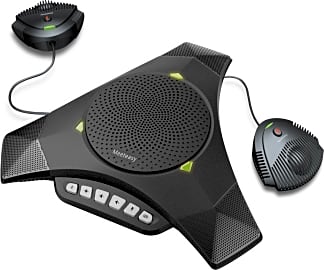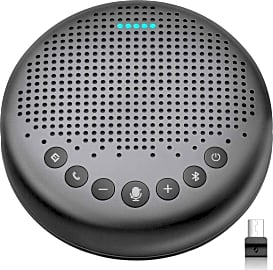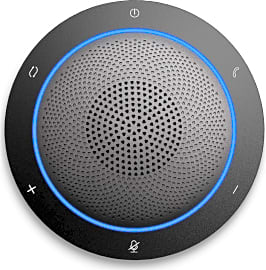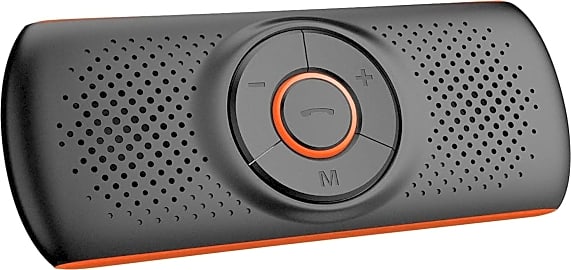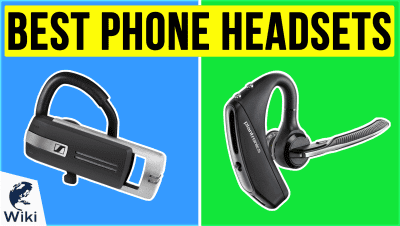The 10 Best Speakerphones

This wiki has been updated 39 times since it was first published in March of 2015. Keep your hands free when driving, cooking, or using your phone or computer with one of these useful Bluetooth speakerphones. We've selected a wide range of models at a variety of prices, including options suitable for small and large office conference rooms, and a few that are designed to be music speakers as much as they are to help you take calls when you're on the go. When users buy our independently chosen editorial recommendations, we may earn commissions to help fund the Wiki.
Editor's Notes
November 16, 2020:
We sent off a few outdated models in the Jabra Tour and the Jabra Speak 510, while updating the 710 to the Jabra Speak 750, which offers superior echo cancellation and microphone coverage. One of the more interesting options in the 750's subcategory of small BT devices for a modest number of callers is the EMeet Luna AI, which can grow with your office as you need thanks to the ability to daisy chain it with another speakerphone of its identical make, effectively doubling the coverage for your conferences.
Something we thought was lacking from our previous iteration was anything that could truly be deployed as a music speaker. For this, we wanted something that offered significant sound quality while also incorporating microphones with noise cancellation features to make sure calls came through clearly. The Harman Kardon Esquire Mini 2 is the more portable of the two models that fall into this subcategory, as it's about the size of a smartphone and boasts a built-in kickstand for fast and easy setup. The Sony SRS-XB43 Extra Bass is just small enough to be portable without sacrificing much in terms of driver size, allowing you to use its wide frequency response to enjoy tunes at home and take it with you anywhere you like.
November 20, 2019:
There are a few reasons why you might want a good Bluetooth speakerphone in your life. Conference calling is ubiquitous in the business world, using a handset while driving is illegal in most of the country, and sometimes you're just too busy around the house to carry a phone around. Of course, you could look at a quality phone headset, many of which boast robust Bluetooth connectivity; two extremely popular manufacturers are Plantronics and Jabra. But if there are multiple people who need to be on the call, you'll need a good speakerphone, and wireless connectivity can greatly increase the level of convenience.
The Jabra Speak 510 and Kaysuda SP200 are both excellent choices for groups up to about 5 or 8 people, and they're both quite reasonably priced. The eMeet OfficeCore M1 is arguably a bit more sensitive, though also more costly, and the Konftel Ego is more affordable but just not quite as loud. For in-car use, the Aigoss T826 is remarkably affordable and the SuperTooth Buddy 2.1 is both popular and blessed by an impressive battery life. The Jabra Tour is also a good choice, although some users find it a bit difficult to use on the go due to the small buttons.
If you're looking to maximize productivity and have a slightly larger budget, the eMeet OfficeCore M2 and Jabra Speak 710 are both very much worth considering. They're both made with premium components, and at least the Jabra sounds so good it even serves as a passable music speaker in a pinch. If you need to pick up sound from all the way across a crowded room, check out the MeetEasy MVoice 8000 EX-B, which boasts a wide coverage area and can be expanded using additional microphones to stretch even farther.
A Quick Overview Of Buetooth Speakerphones
Once the devices have been linked, the user can adjust their call system so that all incoming calls are directed to the speakerphone anytime it is near the cell phone.
A Bluetooth speakerphone is a hands-free phone device that allows a person to take calls without the use of a headset. There are models that plug into a wall through an AC adapter, as well as ones that run on a battery and can be used wirelessly. Bluetooth speakerphones in vehicles have become increasingly popular since many US states banned the use of cellphones while driving.
Some individuals wear headsets or earpieces that connect to their Bluetooth, but those who do not like the feeling of those accessories may prefer a speakerphone. Units designed for the car typically clip onto the visor over the driver's seat, and can be recharged through the cigarette lighter.
The speakers are fairly compact and all of the components are usually integrated into a single housing, but some models may have a speaker which extends through a small arm. Most models have buttons for basic functions such as making and ending phone calls, redialing a number, or adjusting the volume.
Depending on the affiliated cell phone, a Bluetooth speaker can support conference calls and is capable of voice recognition — those that can do the latter are the safest for use in the car since they can be used 100-percent hands-free from start to finish. People who make a lot of calls while driving will appreciate the echo-cancelling technology found in various Bluetooth speakerphones.
The speakerphone connects to the user’s cell phone utilizing Bluetooth technology, which uses radio frequency waves to pair devices without the use of wires or cables. Once the devices have been linked, the user can adjust their call system so that all incoming calls are directed to the speakerphone anytime it is near the cell phone. More advanced models can double as media players, automatically switching from music playback to an incoming phone call.
Surprising Ways to Use Bluetooth
Though usually associated with smartphones, Bluetooth technology is capable of so much more. If one doesn’t have their USB cable with them, but needs to transfer files from one device to another — like from a smartphone to a tablet, or a tablet to an external drive — information can transfer via Bluetooth, expelling the need of USB ports and various cables altogether. So long as two Bluetooth enabled devices are within range of one another, they can send and receive files regardless of whether they are on different networks.
Bluetooth tethering even consumes less battery power than connecting a device directly to the local Wi-Fi network.
Bluetooth also allows for a Wi-Fi sharing technique called tethering. If one device is connected to the Internet and the other is not, Bluetooth can tether the two devices together so each can access Wi-Fi. Bluetooth tethering even consumes less battery power than connecting a device directly to the local Wi-Fi network. Bluetooth users also have the option to create a Personal Area Network. The PAN operates within a 30-foot range and can support up to seven Bluetooth-enabled devices, each of which can communicate with one another, share data, and use the same Wi-Fi connection.
As stated previously, Bluetooth compatible devices are not limited strictly to cell phone use; there are a magnitude of items available on the market designed to mitigate hassle. Wireless keyboards, for example, allow the user to sit anywhere leisurely within the connectivity rage, without being tied down to a desk. If you work in large office, a Bluetooth enabled printer can easily connect to your computer without any hardware, software, or Wi-Fi.
Bluetooth enabled gaming consoles help create a more engaging and active experience, without the fear of ripping a wired console from its hub. These are especially useful in motion-sensitive games, in which the player does a lot of moving and can’t afford to be tied down by wires.
The History Of Bluetooth
It is not associated with it today, but the name Bluetooth actually has violent roots. It was the nickname of Danish King Harald Blatand. King Blatand violently brought together areas of Denmark, Norway, and Sweden in the mid-900s. As for the nickname, some historians conclude it came from the king’s love of blueberries. Others say it sprung from the fact that the warrior’s teeth would turn blue after eating the flesh of his defeated enemies.
The duo invited Nokia, IBM, and Toshiba to organize their own company-based development groups to work on the project.
A Swedish man named Sven Mattisson developed the form of Bluetooth technology that we use today. In 1995 Mattisson’s Ph.D. thesis at the California Institute of Technology on circuit simulators gained the attention of Ericsson Mobile Communications. The company brought Mattisson in to help develop a technology that would allow mobile phones to connect through short-range radio links, rather than cables. This technology was called Multi-Communicator Links (MC Links). By 1997, Intel’s head of technological development Jim Kardach partnered with Mattisson to explore more devices that could be connected using MC Links.
Mattisson and Kardach decided that their technology would be most useful as an open standard in the frequency range of 2.45 GHz. The duo invited Nokia, IBM, and Toshiba to organize their own company-based development groups to work on the project. In 1998, the first MC Links technology became available for public consumption, under the name of Bluetooth. Consumers were initially unimpressed by Bluetooth’s slow download speeds — a mere 721 kilobits per second — and it took Mattisson and Kardach nearly a decade to release a version capable of the 20 megabits per second we're accustomed to today.





